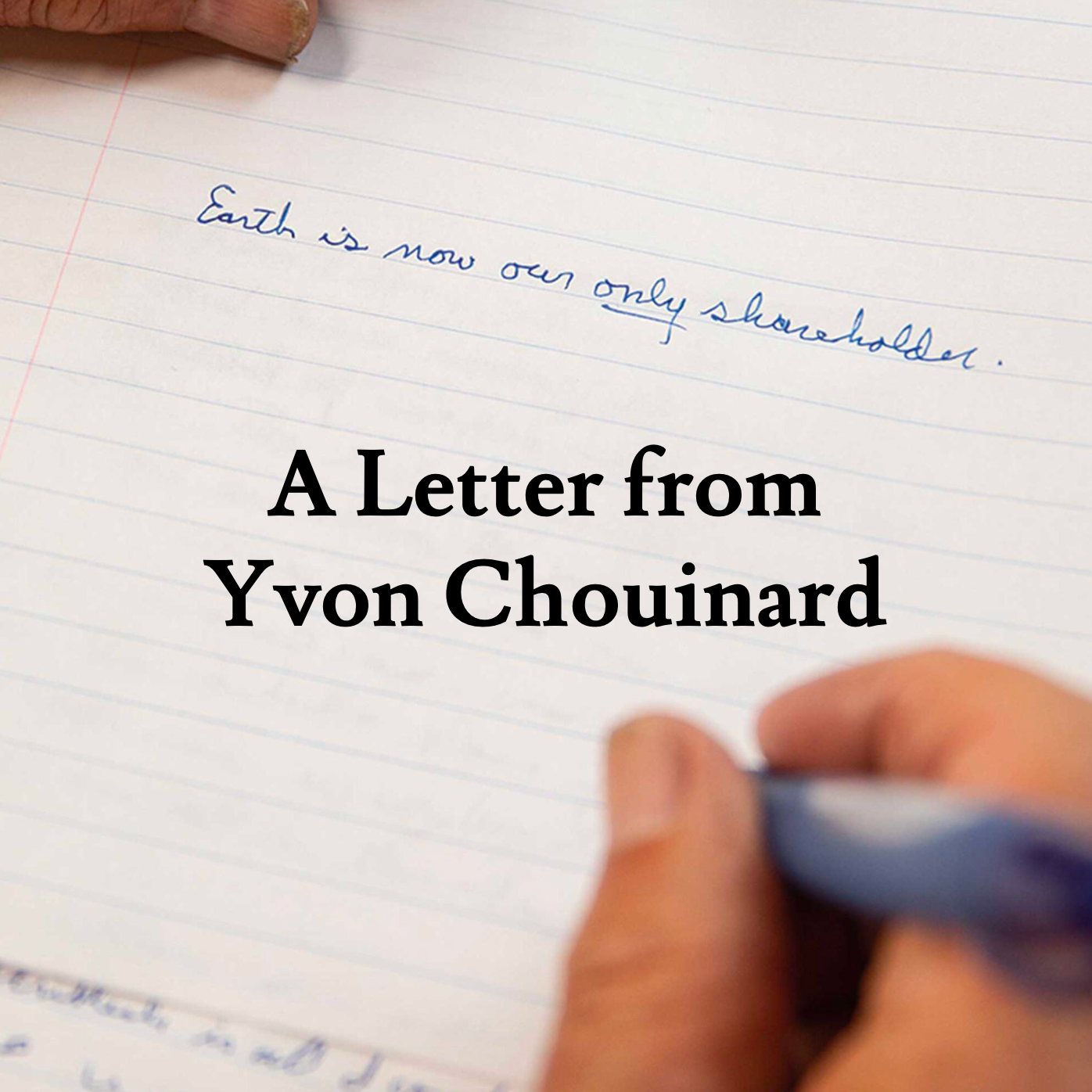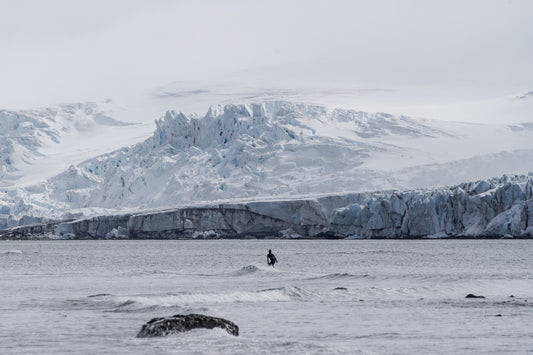The big Chilean welcome continued with uncrowded lineups, a thousand long lefts and a very happy Ben Herrgott, pictured here. Photo Laura Wilson
The wave can be a bit challenging. It's a long wave, almost 800 metres. It’s rarely under six foot at the peak, and has a massive sweep. Staying in the spot is near impossible. But we got some great ones. There were hardly any international tourists and never more than 15 people in the water at one time. We were the first in, most mornings. It seems no one gets up early over there.”
Laura: “I had to take a few deep breaths before we'd head out each morning — it was full on for me. I was out of my limits for sure, but I pushed myself. We got so fit from all the paddling, I could almost say we were fitness machines in the end.”
At the magic left, timing is everything. Photo Laura Wilson
Ben: “Yep, even getting in the water is hectic. You scramble down a path down a cliff and jump from the rocks. You’ve got to time it and paddle against the oncoming whitewash, which pushes you back onto a rock outcrop, like a mini-island. You scramble on top of that, walk on slippery rocks, and then jump in between sets at the front of the wave. It's pretty intimidating.
One day it was 15-to-20 foot. There were local chargers with 10-foot guns and even the pros were getting swept and dragged across the rocks. They weren't just wearing impact vests, but impact suits with padded legs which I hadn’t seen before. Many of them didn't even make it out.”
Hefty magic, indeed. "One day it was 15-to-20 foot," says Ben. "There were local chargers with 10-foot guns and even the pros were getting swept and dragged across the rocks." Photo Laura Wilson
Laura: “I found the landscape and surroundings quite striking. The sand is dark and some mornings it was super foggy, so it felt a little spooky being out there. But the water was so clear — you could look straight down and see crabs and seals swimming all around. The ocean was full of life just below our boards. The air felt heavy with salt and if you looked up there were always birds hovering, searching for food, and towering cliffs all covered in cacti.
In the evening we’d catch sight of the most joyous sunsets, which was a wonderful way to finish off a day of surfing and riding rusty old bikes around the nearby towns.”
Ben: “There's a local philosopher and waterman who lives on the beach. He's made his house out of driftwood and seaweed. He dives and sets his nets out past the rocky crops. It gave us goosebumps talking to him, listening to his wise views on the world and the importance of garnering energy from nature and its elements. One of his comments that stuck with me was that ‘we need to look after our planet because we can't buy a new one.’”
Laura: “His name is Marso and he picks up the long kelp that's prominent along the rocky banks. It’s called cochayuyo. Many local folk harvest the cochayuyo, hang it over rocks to dry, then bundle it up to be sold at markets. It can be used in stews and salads and is a big part of the local diet. It tastes absolutely delicious.
In the end we stayed there for three weeks, but time moved too fast. Next thing I knew, I was starting to pack my bags. I had to return to Australia to apply for a visa for our next leg of travel.”
Marso the marero – or person of the ocean – is a salty philosopher, environmentalist, and collector of cochayuyo. Photo Ben Herrgott
Ben: “I went back up to Santiago and picked up a tiny teeny camper van. My plan was to drive as far south as I could along the coast. I ended up driving 6,000 kilometres on the dot.
I was missing Laura and I had to fight a bit of fear at times as some of the surf was challenging. Really remote waves — big spitting barrels and really heavy paddle-outs. There’s no one around, there's no car park and you're in the middle of nowhere. You’re really outside of your comfort zone.
But it was a good adventure and whenever I met a local surfer, it was quite the experience. The surf community functions differently over there — there's no real ego, there's no secrets, there's no cool factor.
The famous or more popular spots would have maybe eight surfers at most and locals were so excited to surf with someone else. Everyone would cheer each other on in the waves. Out of the water, I’d be getting changed and my fellow surfers would approach me, introduce themselves and shake my hand. It was so refreshing. I love our surf community at home, but we're much nicer outside of the surf environment than in it at times.
I made my way down to a really rugged part of the coast and had some amazing surf with great locals. We all camped in front of the wave. We'd surf in the morning and then eat on the beach together. It was such a warm feeling. The surf was a little challenging and really powerful — heavy backhand barrels dredging sand.
Charismatic monkey puzzle trees (Araucaria araucana) and a fine view of the Llaima volcano from the San Sebastian hiking trail in Huerquehue National Park. Photo Ben Herrgott
I think I fractured the top of my foot in the surf, not too horrible to walk, but it was definitely swollen and black for a couple of weeks. So I changed my plans a little and went inland to the mountains. What a sight — being surrounded by white-capped volcanoes and very few tourists.
Eventually I went back to the coast. I took my time driving further south, just camping and exploring until I got to an island a bit before Patagonia. On a trip to Alaska, many years ago, Kevin Starr told me that it was his dream to surf there, which put it on the map for me.
It was beautiful. I surfed on my own once again. It can be a heavy slab, which is not my skillset, but luckily when I got there, it was small but sort of perfect. It runs in 50 centimetres of water.
To get there was a challenge in itself. There is an army base and lighthouse to get past first. Crossing the army base, you have to scream for someone to get their attention. If they want to let you through, you are off but need to sign your life away. Next you have to clamber down some cliffs with ropes, drop into the mud and there you find that perfect, beautiful wave.
Further around the island I had a magic session at a picturesque point break. It was mellow but fun and there were cows walking on the beach, eating the kelp; the morning light making it extra special for me.
The amount of surf and the quality of waves in Chile is unbelievable. The locals really impressed me with their barrel riding. But amongst all the beauty and good vibes, there were some uneasy feelings that came up for me.
It looks like logging is overtaking the country. I came across a cool surf spot next to a simple, little town and the entire hill behind the town was razed. It would have been a beautiful green hill once but it was just dirt and branches, all crushed by big bulldozers.
Salmon farming is also really in your face. When I was driving around the island, every single cove that was not exposed to waves, every beautiful beach from my 2010 Lonely Planet, was not the pretty place that it used to be. There were salmon farms everywhere. Yes, it's providing a lot of employment, but forget about fishing in the area, forget about biodiversity. It's destroying the water. It really hits you in the belly. It's not just your brain telling you this is bad for the planet, it's right there in front of you, you can see it, feel it.
Golden hour at the birthplace of Chilean surfing. Photo Laura Wilson
But on a positive note, Chileans keep things local. So local that you don’t see big chain stores, nor do you see big trucks moving products up and down the coast. Every small town has their own bunch of independent stores, bringing many economical and environmental positives.
All in all, we had a memorable time in Chile. I just love the authenticity of this country.”
Opening image: Ben negotiates peak hour en route to the magic left. Photo Laura Wilson
















































